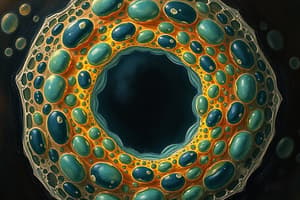Podcast
Questions and Answers
What are the major components contained within the eukaryotic nucleus?
What are the major components contained within the eukaryotic nucleus?
Chromosomes, Chromatin, Nuclear matrix, Fibrillar network, Nucleoli, r-RNA and ribosomes, Nucleoplasm
What does the nuclear envelope consist of?
What does the nuclear envelope consist of?
- Two cellular membranes (correct)
- Four cellular membranes
- One cellular membrane
- Three cellular membranes
The outer membrane of the nuclear envelope is continuous with the rough endoplasmic reticulum.
The outer membrane of the nuclear envelope is continuous with the rough endoplasmic reticulum.
True (A)
What is the function of the nuclear lamina?
What is the function of the nuclear lamina?
What must happen to lamin phosphorylation during prophase?
What must happen to lamin phosphorylation during prophase?
The huge macromolecular complex that facilitates transport in and out of the nucleus is called the ______.
The huge macromolecular complex that facilitates transport in and out of the nucleus is called the ______.
What structural shape do nucleosomes resemble?
What structural shape do nucleosomes resemble?
The solenoid model defines the packing of DNA as what size fiber?
The solenoid model defines the packing of DNA as what size fiber?
What role do nuclear pore complexes (NPC) play in the nucleus?
What role do nuclear pore complexes (NPC) play in the nucleus?
Nucleosomes are formed from proteins known as histones.
Nucleosomes are formed from proteins known as histones.
What is the primary function of the nuclear lamina?
What is the primary function of the nuclear lamina?
The fluid contained within the nucleus is called the ______.
The fluid contained within the nucleus is called the ______.
Match the following components of the nucleus with their functions:
Match the following components of the nucleus with their functions:
Which proteins are part of the nuclear lamina?
Which proteins are part of the nuclear lamina?
The inner membrane of the nuclear envelope is not associated with any protein structures.
The inner membrane of the nuclear envelope is not associated with any protein structures.
What is the helical structure that forms from the compacting of nucleosomes called?
What is the helical structure that forms from the compacting of nucleosomes called?
Flashcards are hidden until you start studying
Study Notes
Eukaryotic Nucleus - Structure
- A dense, amorphous mass contained within a nuclear envelope.
- Major components are: chromosomes, chromatin, nuclear matrix, fibrillar network, nucleoli, ribosomal RNA (rRNA), ribosomes, and nucleoplasm.
- Nucleoplasm is the fluid inside the nucleus.
The Nuclear Envelope
- Two cellular membranes that act as a barrier to ions, solutes, and macromolecules.
- Membranes fuse to form pores which are complex assemblies of proteins.
- Outer membrane is continuous with the endoplasmic reticulum (ER) and has ribosomes attached.
- Inner membrane is bound to the nuclear lamina which is a filamentous network that supports the envelope and provides points of attachment for chromatin.
- Nuclear lamina fibers are composed of proteins called lamins which belong to the intermediate filament protein family.
Lamin Phosphorylation
- During prophase, lamin phosphorylation disassembles the nuclear lamina, allowing for nuclear envelope breakdown.
Laminins
- They are extracellular proteins.
The Nuclear Pore Complex (NPC)
- It is a large complex of proteins necessary for the transportation of materials into and out of the nucleus:
- Proteins synthesized in the cytoplasm are transported into the nucleus.
- RNAs manufactured in the nucleus are transported to the cytoplasm.
Nuclear Pore Complex (NPC) Structure
- It is a huge macromolecular complex with octagonal symmetry.
- It has 8-fold repetition of subunits.
- It contains 30 to 50 proteins called nucleoporins.
- Nucleoporins are symmetrical on both cytoplasmic and nuclear sides.
- Some nucleoporins contain phenylalanine and glycine repeats (FG Nups).
DNA in the Nucleus
- The nucleosome is a structure that regulates transcription, integrates specific loci, and protects gene expression.
The Solenoid Model
- Nucleosomes resemble beads on a string, and they are further compacted into a helical shape due to interactions between the amino-terminal tails of the octameric histones. This helical structure is called a solenoid.
- Solenoids define the packing of DNA as a 30nm fiber of chromatin, resulting from the helical winding of at least 5 nucleosome strands.
Eukaryotic Nucleus Structure
- Major components:
- Amorphous mass enclosed by a nuclear envelope
- Chromosomes
- Chromatin
- Nuclear matrix
- Fibrillar network
- Nucleoli
- r-RNA and ribosomes
- Nucleoplasm
Nuclear Envelope
- Consists of two cellular membranes
- Provides a barrier for ions, solutes, and macromolecules
- Membranes fuse to form pores
- Complex assemblies of proteins
- Outer membrane has ribosomes and is continuous with RER
- Inner membrane is bound to the nuclear lamina
- Nuclear lamina is a filamentous network that supports the envelope
- Nuclear lamina provides attachment sites for chromatin
- Nuclear lamina fibers are composed of proteins called lamins, part of the intermediate filament protein family
- Lamin phosphorylation during prophase disassembles the nuclear lamina, allowing for nuclear envelope breakdown.
- Lamins are different from laminins, extracellular proteins
Nuclear Pore Complex
- A large number of proteins are synthesized in the cytoplasm and transported into the nucleus
- RNAs are manufactured in the nucleus and transported to the cytoplasm
- Huge macromolecular complex with octagonal symmetry
- 8-fold repetition of subunits
- 30-50 proteins
- Nucleoporins are symmetrical on both cytoplasmic and nuclear sides
- FG Nups are also found in the nuclear pore complex
DNA in the Nucleus
- Nucleosomes resemble beads on a string, regulating transcription, integration of specific locus and gene expression
- The nucleosomes further compact into a helical shape, called a solenoid, through NH2 terminal protein interactions of the octameric histones.
- The solenoid defines the packing of DNA as a 30nm fiber of chromatin, due to the helical winding of at least five nucleosome strands
Studying That Suits You
Use AI to generate personalized quizzes and flashcards to suit your learning preferences.




